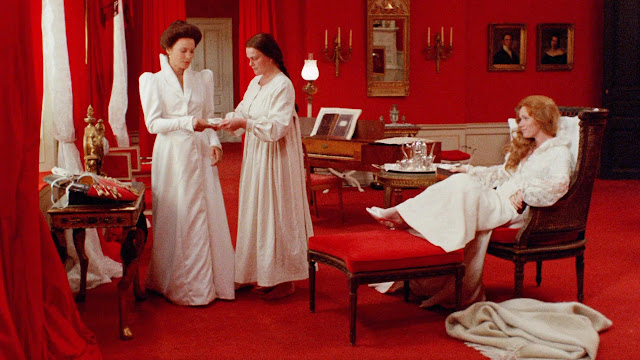My Favorite Films, Plague Edition (Volume 7): Cries and Whispers
Cries and Whispers (1972)
Written and Directed by Ingmar
Bergman
Starring Harriet Andersson and Liv
Ullmann
A couple of years ago, I wrote
about how some artists can divorce their personal lives from their art, while
others entwine the two. For example, Alfred Hitchcock was obsessed with
victimized, beautiful, distant, cold women, and portrayed them endlessly in his
films (Vertigo, The Birds). Ditto Ingmar Bergman (1918-2007), perhaps the
greatest-ever director of actors (as opposed to spectacle, scenery, or crowds).
He was famous for his abusiveness and complete domination on the movie set, and
in fact became so entwined with his female actors that he had extramarital
affairs with three (Harriet Andersson, Bibi Andersson, and Liv Ulmann, with
whom he had a child). He was married five times and had nine children, none of
whom he paid much attention to, being consumed with his 45 films and multitude
of directed plays. Bergman’s modus operandi was to use his films
to reflect on and come to terms with his many personal demons,
especially his love/hate relationships with women. His work was his psychotherapy.
This places the viewer in the painful, exciting, voyeuristic role of watching
another human's struggles and therapy up close, like peering into a sex therapy
session. The prime example of this work was Cries and Whispers, one of
the greatest films ever made, and maybe the one with the best acting ever.
Cries and Whispers tells the
story of several days in the lives three sisters, drawn together in the family home as one of them
dies, horribly, of tuberculosis. In a later interview, Bergman describes being
obsessed with a year-long vision of women dressed in white, acting in front of a
blood-red curtain. In the film, this translates into red walls, red bedspreads,
red ceilings, red curtains cascading to the floor. To me it feels not just like
blood, but menstrual blood. The three women (two of whom were Bergman’s
mistresses) dominate the film, while their husbands and lovers fill mostly
ineffectual, pathetic, or contemptible character roles. Clearly these women
mostly have love, hate, and passion for each other, not for anything in the outside
world. Hence, this blood-red, claustrophobic prison confines and intensifies
the action. The occasional forays out into the estate gardens feel like another
universe. The whole film feels like we are looking at these women through a
microscope, with not a single flinch or eye movement escaping the camera’s
gaze. For example, watch the opening. Not a word is spoken, but the dying Agnes’face communicates a whole novel’s worth of emotion in a few seconds. This is painfully exquisite acting by Andersson
and direction by Bergman.
The film continues to explicate the
sisters’ history, but not ever completely. The screen turns red at times, and
we see flashbacks (or are they dreams or fantasies?) of past events, including
a pathetic, unsuccessful attempt at suicide by a husband and a vision of a
cold, distant mother. At midway in the film, Agnes dies, in a wrenching,
choking fit that is perhaps the most brutally intimate thing I have seen on film. Andersson later said she did it by channeling the memory of her bedside
experience of her own father’s death. I cannot think of a better acting
performance than this one. The ensemble cast is superb stew of dysfunction. Except
for the maid Anna, who nurtures the dying Agnes like Mary in the Pieta,
none of the sisters can manage to offer any real comfort or love to their
sister, even pulling away screaming when she tries to touch them. Death does not always bring out the best in families, and our own weaknesses often prevent us from reaching out to others. Bergman in therapy.
I do not know of any film that
establishes its own universe the way this one does. We are desperate to get out
of this micro-vortex, but are instead hypnotized and compelled to stay in it to
watch these three superb women love and tear each other’s eyes out. While not
Bergman’s most popular international film, Cries and Whispers became his
most famous, even playing in US drive-ins (!) for a time. It is a cinematic
experience like no other, and a major work of art.



Comments
Post a Comment